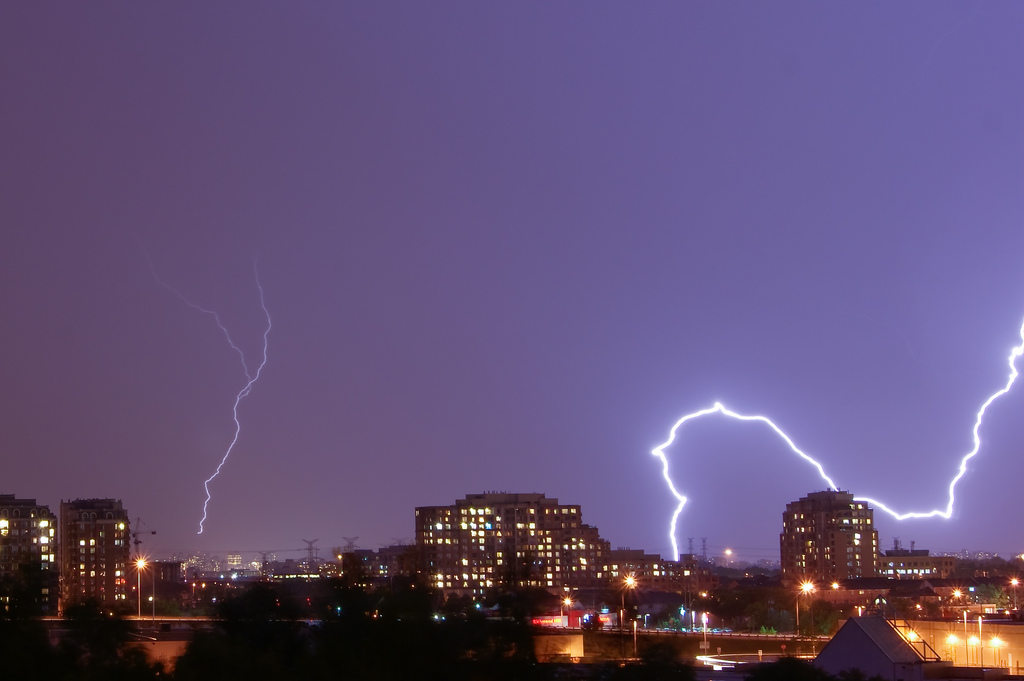Winter is over. No more whiteouts. No black ice. No snow squalls. But summer weather brings its own dangers with it. Here are some safety tips for the summer weather.

Lightning
According to Environment Canada, on average 10 Canadians are killed each year after being struck by lighting. Another 100 to 150 more are injured. These are life-altering injuries, often having disturbing consequences such as memory loss and physical disabilities.
The first thing to remember is if you can hear thunder then you can be struck by lightning. It doesn’t matter how far away the storm seems to you. “When it roars, go indoors,” Geoff Coulson of Environment Canada said.
If you’re outdoors and can’t get inside, do NOT stand under a tree to keep dry from any rain that might be accompanying the system. Stay away from tall structures such as flagpoles or large trees.
If out on a boat, get to shore as quickly as you can. Do not use any metal objects. Metal doesn’t necessarily attract lightning, but it is an excellent conductor. People have been known to be injured using a computer.
Remember: there is no safe place outdoors during a thunderstorm.
Severe thunderstorms
There are many things severe thunderstorms bring. This can include heavy rain, lighting and flash flooding. Never go near rivers or streams during heavy rains. And if you’re driving, never try to drive through water. You don’t know how deep that water actually is.
Strong thunderstorms often have hail. The size of hail can vary from pea-sized to that the size of a toonie. Grapefruit-sized hail has even been reported. Alberta is home to “hail alley”, which runs from south of Calgary to north of Red Deer. If there’s hail, seek shelter immediately.
Although Canada does get tornadoes, some of the most damaging events are simply “wind events.” In fact, the most wind damage that we see in Canada is caused by straight-line winds. These winds can reach tornad0-like force.
Various types of wind events include microbursts, downbursts, squall lines and derechoes. According to Enviornment Canada, the Prairies see “45 to 50 thunderstorm-related severe wind events which are not tornadoes.”
In 2012, a severe thunderstorm tore across eastern Ontario and its straight-line winds reached up to 170 km/h. The winds downed tens of thousands of trees and knocked out power to more than 25,000 people. It’s these kinds of winds that many people mistake for a tornado. That’s why when there’s a report of a twister, Environment Canada sends out a team to assess the damage.
Tornadoes
Yes, tornadoes can occur in Canada. We have two “tornado alleys,” areas where tornadoes form most frequently. One is in Ontario and another is in the southern prairies. But it doesn’t matter where you live, tornadoes can happen anywhere.
If a tornado warning is issued, take shelter in a basement. If you don’t have a basement or live in an apartment, the most important thing is to put as many walls between you and the outside as possible and to stay away from any windows. It’s not winds that kill people in a tornado, it’s debris: the remnants of trees, houses, or whatever else may become a projectile during a tornado.
Of course there’s also the heat and humidity. Keep hydrated on hot days and make sure you wear sunscreen. Also try to stay somewhere where it’s air conditioned.
On days when the air quality health index is high, try to stay indoors.


Comments